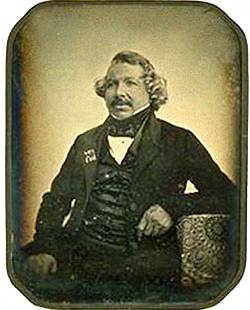*Image Credit: Wikimedia Commons After years of development, the French Government made a startling declaration on August 19, 1839: the Daguerreotype photographic process would be “free to the world” in perpetuity. Louis Daguerre, having worked in tandem with Nicephore Niepce, had created a method to capture images using silver salts and iodine crystals. After a brief exposure to mercury vapor, the picture would be developed – modern photography was born. It is difficult to imagine in an age when smartphones act as pocket-sized cameras snapping photos in an instant, but the process to create these images once took minutes at a time or longer. Niepce had worked through the 1820s to produce a film using bitumen in order to take a picture, creating the first permanent photograph in 1826. His process required hours or days worth of light in order to record the image, something his later association with Daguerre was able to shrink somewhat. When Daguerre took sole charge of testing and enhancing the equipment after Niepce’s death, he looked toward the example of Johan Schulze, a German scientist who demonstrated the light transmission properties of silver chloride and silver nitrate a century before, to refine Niepce’s process even further. Through the process of trial and error, he settled on exposing a copper sheet with a thin silver coating to gaseous iodine, resulting in a layer of silver iodide. Once placed in the camera and exposed to light, an image would be captured, though still requiring a significant period of time. What made the Daguerreotype process unique came in the discovery of the properties of mercury: the vapor produced when the metal is heated to 167 degrees Fahrenheit accelerated the development of the image. Thus, after just a few minutes of light, the faint shadow of a photograph could be turned into a fully fixed plate. Much like Polaroid cameras in the 20th century, people could now have photographs in a markedly shorter amount of time. However, due to the sensitivity of the materials, the pictures had to be placed under glass and viewed at a certain angle. The French government, seemingly aware of the singular nature of the technology, refused to allow it to be held privately. Daguerre managed to apply for a patent in Great Britain days before France made the process public knowledge, meaning England would be the only place he could earn income from licensing. He had been inadvertently robbed of a fortune. Most people took advantage of the Daguerreotype process to have portraits taken of themselves or family members. Only a handful of artists opted for landscapes — including Daguerre himself, whose rare photos of the Paris streets from the 1830s have become priceless even though the long exposure times prevented the traffic and pedestrians from being shown. Within a few years, the technique only took seconds to complete. Two decades later, however, the advancement of the wet colloidon process in the 1850s had pushed the Daguerreotype method to the margins. Cheaper but with similar clarity, it would be the grandfather of the film photography used in the 20th century.
August 19, 1839 CE – Louis Daguerre’s Photographic Process is Released by the French Government
*Image Credit: Wikimedia Commons After years of development, the French Government made a startling declaration on August 19, 1839: the Daguerreotype photographic process would be “free to the world” in…
495
